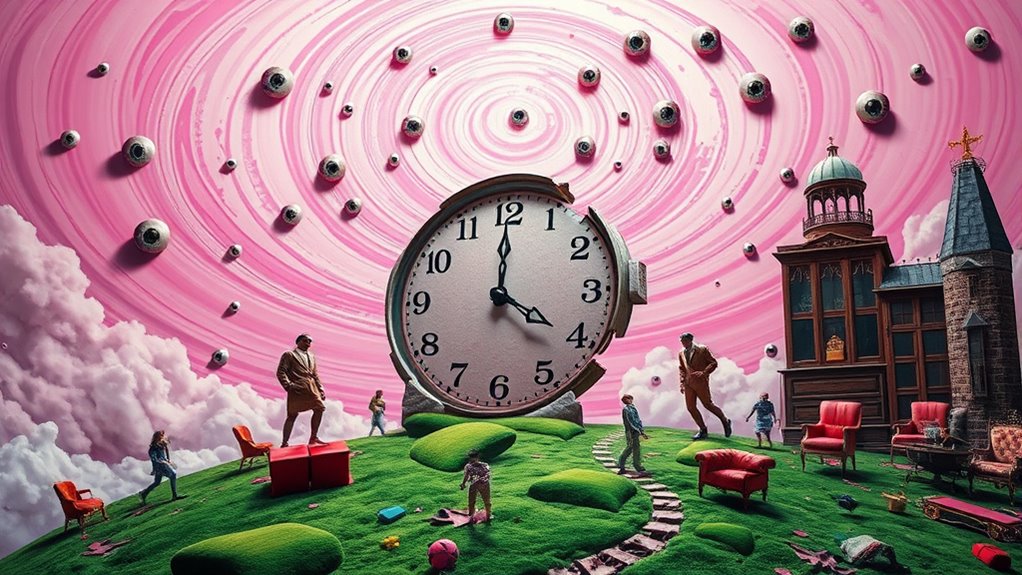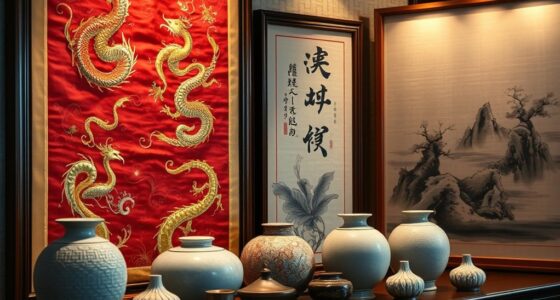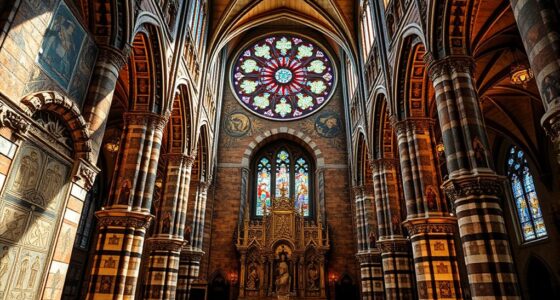Dada and Surrealism revolutionize art by tapping into dreams, the unconscious, and chaos to challenge societal norms. You’ll see how both movements use automatism, collage, and bizarre imagery to express raw emotions, fears, and desires. Their goal is to ignite social change and question traditional values through provocative, unpredictable works. By exploring these movements further, you’ll discover how they continue to inspire rebellion and transform art’s role in society.
Key Takeaways
- Both movements used automatism to access the unconscious, blending dreams and reality in their artworks.
- Dada rejected societal norms through chaos, satire, and provocative techniques, aiming to challenge authority.
- Surrealism sought to reveal hidden truths via dream imagery, hallucinations, and subconscious exploration.
- Both emphasized spontaneity and irrationality to promote social change and question traditional aesthetics.
- Their combined legacy inspired revolutionary art that confronts societal values through dreams, satire, and activism.

Dada and Surrealism are two influential art movements that challenged traditional ideas of aesthetics and meaning. They broke away from conventional techniques, encouraging artists to explore the subconscious and question societal norms. You might find that these movements emphasize spontaneity, irrationality, and the power of dreams as sources of inspiration. Dada, emerging during World War I, was a direct response to chaos and destruction, using chaos itself as a form of protest. Surrealism, which followed, aimed to *liberate* the unconscious mind’s hidden truths, often through dream imagery. Both movements sought to revolutionize art, making it a tool for political activism and social critique.
In Dada, you would discover a disdain for logic and reason, favoring chaos as a way to undermine the established order. Artists employed automatism techniques—methods that involve creating art spontaneously, without conscious thought—to bypass rational control. This approach allows your subconscious to guide your hand, producing unpredictable and raw works that defy traditional aesthetics. Dadaists also used collage, readymades, and absurd juxtapositions to challenge perceptions and provoke viewers. Their aim wasn’t just to create art but to confront societal values and question authority, making political activism a core element of their practice. They believed that art could serve as a weapon against bourgeois complacency, inspiring change through shock and satire. Additionally, the use of portability in some Dada artworks enabled artists to exhibit and distribute their provocative pieces widely, amplifying their message.
Surrealism, building on Dada’s rebellious spirit, takes you deeper into the *dimension* of the subconscious. Surrealist artists embraced automatism techniques as well, such as automatic drawing and writing, to access raw, unfiltered thoughts. These techniques help you tap into your inner world, revealing desires, fears, and memories that lie beneath conscious awareness. Surrealists sought to depict dreams and hallucinations, blurring the line between reality and imagination. Their art often features bizarre, fantastical imagery that challenges your perceptions and invites you to interpret meaning beyond rational understanding. Like Dada, Surrealism also incorporated political activism, especially in its later years. Many surrealists believed that transforming society required freeing the mind from oppressive structures, and their art served as a vehicle for revolutionary ideas, advocating for liberation and social change.
Both movements use their innovative techniques and radical ideas to push boundaries and inspire activism. Whether through the chaos of Dada or the dreamlike landscapes of Surrealism, they invite you to see the world differently—to question, to rebel, and to imagine new possibilities. Their shared focus on automatism and political engagement underscores their roles as catalysts for cultural and societal transformation. *Essentially*, both Dada and Surrealism challenge you to embrace intuition, reject conformity, and recognize the power of art as a means of revolution and self-discovery.
Frequently Asked Questions
How Did Dada Influence Later Avant-Garde Movements?
You see, Dada profoundly shaped later avant-garde movements by embracing collage techniques and an anti-art philosophy. It encourages you to challenge traditional aesthetics, break boundaries, and question societal norms. Dada’s focus on randomness and chaos inspires you to experiment freely, fostering innovation. Its rebellious spirit and emphasis on found objects revolutionized art, influencing movements like Pop Art and Fluxus, which continue to push creative limits today.
What Are the Key Differences Between Dada and Surrealism?
You might wonder about the key differences between Dada and Surrealism. Dada is characterized by artistic rebellion, often using chaos and absurdity to challenge traditional norms. Surrealism, however, explores dream symbolism, exploring the unconscious mind and revealing hidden desires. While Dada aims to shock and provoke, Surrealism seeks to reveal deeper truths through dream-inspired imagery, making their approaches distinct yet connected in their revolutionary spirit.
Who Were the Leading Artists Behind Dada and Surrealism?
You’d find that leading Dada artists like Hannah Höch and Marcel Duchamp created Dadaist collages to challenge traditional art, while Surrealist pioneers like André Breton and Salvador Dalí used automatic writing to tap into the subconscious. These artists drove revolutionary movements, with Dada rejecting reason and logic, and Surrealism exploring dreams and the unconscious mind. Their innovative techniques pushed boundaries, shaping modern art’s evolution.
How Did Political Contexts Shape These Art Movements?
You might think politics stay out of art, but in reality, political upheavals and cultural revolutions deeply shape creative movements. Dada and Surrealism emerged as rebellious responses to chaos, war, and societal breakdown. They challenge norms, revealing how artists channel turmoil into revolutionary visions. Ironically, these movements were born from upheaval, turning societal despair into surreal masterpieces that question authority and redefine cultural boundaries.
What Role Did Dreams Play in Surrealist Artworks?
You see that dreams play a vital role in surrealist artworks by serving as a gateway to subconscious exploration. Artists like Salvador Dalí use dream imagery to tap into hidden thoughts and desires, creating surreal scenes that challenge reality. This focus on dreams allows you to understand the inner mind’s complexities, blurring the line between the conscious and unconscious, and encouraging a revolutionary approach to art and perception.
Conclusion
You now hold the secret to unlocking dreams and revolution through Dada and Surrealism. These movements didn’t just shake up art—they tore apart the fabric of reality itself, unleashing a whirlwind of chaos and imagination so powerful, it’s like riding a cosmic rollercoaster through the universe’s wildest dreams. Embrace their chaos, and you’ll realize that art’s true magic lies in turning the impossible into your new reality—because nothing is too crazy to become masterpiece.









